Back in 1940s and 50s America it wasn’t a question if the forest should be ripped down, it was a question of how quickly that pesky forest could be dispatched with and who could figure out the best way to do it. Such was the case when the US Government put out a contract to clear 25,000 acres of forest in the wilds of Montana at the site of the Hungry Horse Dam projects. The mammoth dam would be used to help control the Flathead River and manage water in the Columbia River drainage area by creating a huge reservoir behind it. The physical dimensions of the forest area that needed clearing 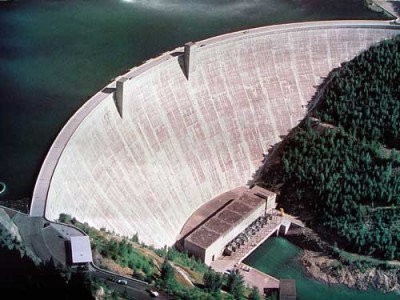 were huge, some 34 miles long and 3.5 miles wide at points. Basically it was 35 square miles in total. The first wave of clearing came in the form of loggers which essentially picked the whole area clear of good old growth trees that were merchantable. Even with the good spruce, pine, and fir timber harvested from the area, the place looked as though it had never been touched. To the casual observer, this was 35-square miles of completely virgin forest that had to be taken down and removed. All of the logs and limbs had to leave because otherwise when the area was flooded they would float to the top and wreak havoc with debris booms and other catches that would prevent debris from entering the huge electricity generating turbines which would also be part of the dam. Hungry Horse was no weak sister of a project. The dam itself was the fourth largest one in the world when it was completed in 1953. 2,115 feet long and 560 feet tall, it was essentially a three million cubic yard block of concrete. Only the Grand Coulee, Shasta, and Hoover dams were larger at that time.
were huge, some 34 miles long and 3.5 miles wide at points. Basically it was 35 square miles in total. The first wave of clearing came in the form of loggers which essentially picked the whole area clear of good old growth trees that were merchantable. Even with the good spruce, pine, and fir timber harvested from the area, the place looked as though it had never been touched. To the casual observer, this was 35-square miles of completely virgin forest that had to be taken down and removed. All of the logs and limbs had to leave because otherwise when the area was flooded they would float to the top and wreak havoc with debris booms and other catches that would prevent debris from entering the huge electricity generating turbines which would also be part of the dam. Hungry Horse was no weak sister of a project. The dam itself was the fourth largest one in the world when it was completed in 1953. 2,115 feet long and 560 feet tall, it was essentially a three million cubic yard block of concrete. Only the Grand Coulee, Shasta, and Hoover dams were larger at that time.
As you can imagine, clearing that much area in the wilds of Montana wasn’t a job that most people had ever considered completing before. Firms from all over the country began to send in bids and proposals as to how they were going to complete the work. While we’re not sure what they were proposing for a method we know that the two guys who came up with the winning formula were S.L. Wixson and John H. Trisdale of Redding, California. Their idea, never before seen at the time was to essentially tie two big bulldozers together with steel cable and use the the cable as a giant scythe, cutting down and ripping over anything on its path. The men figured that this idea would be the most cost effective and quickest way to get the land cleared within the parameters that the government set for the work to be done. They apparently tested this idea around their native area of Redding, California before sending in their bid for the work in 1947. Little did they know that their bid was some $2,000,000 less than the next closest one…in 1947 dollars! That’s nearly $20,000,000 in today’s money. As government contracts are notoriously awarded to the lowest bidder, they got the work.
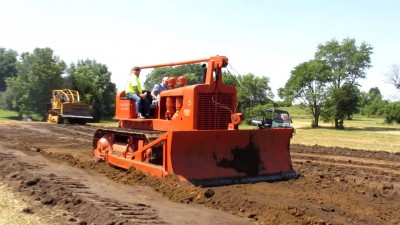 For their workhorses the men chose Allis-Chalmers HD-19 bulldozera. These 40,000lb monsters were the biggest iron of that time (unless you wanted something custom built…and we’ll get to that heap of coolness in a bit) which rolled off an assembly line so they ordered a handful of the big tractors, equipped them with winches, and hundreds upon hundreds of feet of big inch and quarter thick steel cable. Interestingly at the same time that the government awarded Wixsom and Trisdale their contract, they also hedged their bets a little and awarded a contract to JJ Reese, a Montana based land clearing contractor. The two operations could not have gotten off to more different beginnings.
For their workhorses the men chose Allis-Chalmers HD-19 bulldozera. These 40,000lb monsters were the biggest iron of that time (unless you wanted something custom built…and we’ll get to that heap of coolness in a bit) which rolled off an assembly line so they ordered a handful of the big tractors, equipped them with winches, and hundreds upon hundreds of feet of big inch and quarter thick steel cable. Interestingly at the same time that the government awarded Wixsom and Trisdale their contract, they also hedged their bets a little and awarded a contract to JJ Reese, a Montana based land clearing contractor. The two operations could not have gotten off to more different beginnings.
Outside of a few small hangups, the big Allis tractors pulling the steel cable worked as good and maybe better than the two guys could have imagined. On the other hand Reese was in big trouble. According to government construction reports he had cleared only a quarter of his land in half the length of the contract. Seeing the success that Wixson and Trisdale were having with their crew and methods, those guys got that work as well.
The only real problem that would slow up the cable ripping operation were the big 4-5 ft tall stumps that were left by the loggers when they cleared all of the old growth trees out of the forest. Those were so deeply rooted that even the mighty dozers couldn’t budge them and when the cable got hung up one one, time was lost backing up, freeing it, and moving ahead. The Montana winters were far too harsh to work through for clearing so the guys finished what they were doing for the year (ahead of schedule) and went home to come up with a plan.
Their solution (pictured at left) was simple and awesome. The guys had an eight foot diameter steel ball built. The ball had a very strong axle going through it and on either end were massive chains and cable attachment points. The beauty of the ball is that it completely solved the stump hang up issue. In the event that the ball hit an object it wouldn’t roll over the bulldozer drivers could use the winches on their machines to shift the ball left or right. The guys went from moving at a good clip with the work to absolutely blazing through it. There were days on relatively flat ground where a single team of two tractors and one ball could clear over 200 acres before the sun went down. The ball itself was no flyweight. All of that steel added up to a 10,000 curb weight.After proving their concept, the guys expanded the operation by adding several teams of machines.
To picture how this operation actually worked, enivision a giant U-shape. The tops of the U are 500ft apart and at each top there is a big bulldozer. At the bottom of the U is the steel ball with 100 ft of inch and a half cable that has a swivel on each end where an additional 400ft of inch and a quarter cable is attached. The dozers move ahead, blazing their own trail at about 1-mph. Everything caught in the path of that slow moving cable is grabbed and either (a)snaps (b)rips out of the ground (c) shreds to splinters. We’re thinking that the guys driving the bulldozers had the greatest job in the world. They had to have felt like super heroes out there. You’d start the day in a forest and end in an area that look like it was struck by a tornado.
For the 1950 campaign, Wixson and Trisdale split and operated as two contractors rather than as a single entity. We cannot find anything to suggest this was done out of anger or spite. It seems more like it was done because the guys knew there was years worth of forest left to clear and that they could each make a small fortune clearing it. Seems like smart business to us. At the time of the operation, which the men dubbed, “Operation Highball” it was estimated that a pair of dozers with the steel ball and cable method were completing the work of 12 machines working independently.
So as you may have figured, there was a second part of this operation which was essentially the “cleanup” portion of the program. After the ball and cable had done their handiwork and basically mowed down a section of forest, the trees, brush, and limbs would have to be piled up, allowed to dry for a few weeks, and then burned. The trees weren’t considered large enough to be taken to sawmills so they were essentially just “in the way” and burning them was the best way to dispose of them. Consider the last bonfire you attended at home for a pep rally or at a festival or something. Now think of a pile of felled trees 30-40 feet high being lit on fire. Yup, your bonfire sucked in comparison to that. So what were these giant piles created by? A giant tractor of course. Like the dam it was clearing the land for, it was among the biggest ever built at the time.
Commissioned by Tisdale, this absolute monster was known as the “Super Pusher Cat” and was built by Peterson Caterpillar in California. Basically what you are looking at is a pair of D8 Caterpillar bulldozers hooked together and running through a single pair of tracks. This is a photo of the machine just after it was built and before it was fitted with the toothed blade used to “mop up” all of the downed trees and brush created from the clearing teams. Reportedly this thing could grunt and push those 30-40 foot tall stacks of trees for a football field at a time without bogging down.
 And here is that pusher blade we were just talking about. Apparently the machine was stronger than the blade as it was not uncommon for the welders to have to step in and replace teeth after a long day working in the field. Our only lament about this whole deal is that there’s no video (that we can find) of any part of the operation in action. Just watching the dozers mow down the forest like it was made of corn stalks would be something that’s worth the price of admission.
And here is that pusher blade we were just talking about. Apparently the machine was stronger than the blade as it was not uncommon for the welders to have to step in and replace teeth after a long day working in the field. Our only lament about this whole deal is that there’s no video (that we can find) of any part of the operation in action. Just watching the dozers mow down the forest like it was made of corn stalks would be something that’s worth the price of admission.
The two crafty entrepreneurs/contractors got their work done early and by all accounts made a great deal of cash in the process. It was Wixsom who completed his land first by a mere five days. While we’re not sure which of the two actually came up with the ball idea, we know that they both benefitted from it. The “high ball” clearing method was widely hailed as a breakthrough at the time and the idea was used around the globe for large land clearing projects.
What ever became of the original steel balls used at the Hungry Horse project?
Believe it or not, several of them are still around. There’s at least one out in California back in the Redding area where Trisdale and Wixsom had their original business. The one pictured to the left is near the Hungry Horse dam, and there are a couple others scattered about. One of the things that amazes us is that they aren’t all smashed to bits or dented too badly. At 10,000lbs they were made from some pretty stout and thick steel plate.
We love stories like this. Stories about smart guys applying practical knowledge in a creative way to solve a problem that others could not. Today if this occurred there would be an eight month study, months of deliberation, permitting problems, people chaining themselves to the trees and some protected slug that would halt the whole project. American in 1950 was a place where things got done and they got done right now. It would be cool to have those days back.
Wixsom and Tridsale….you guys rule. 100% BangShift approved!



















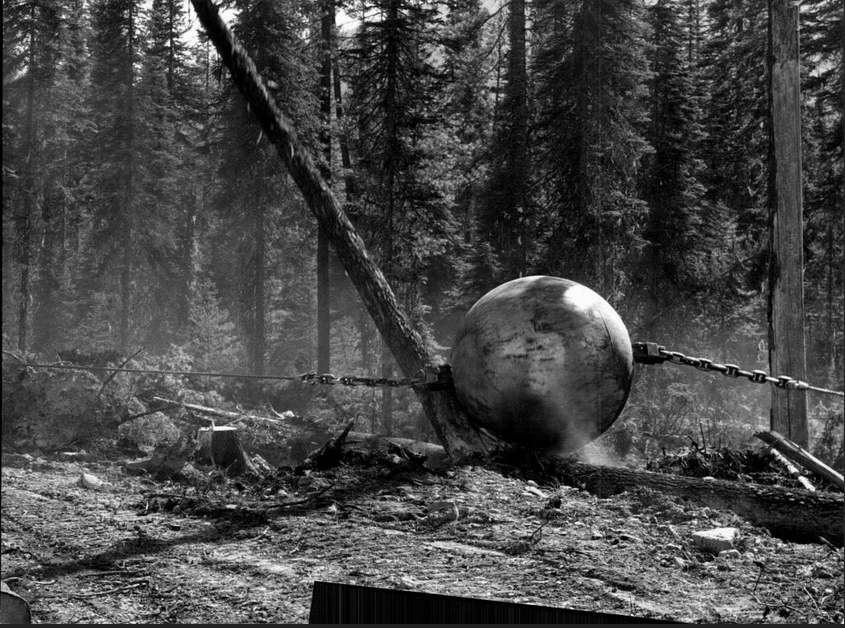
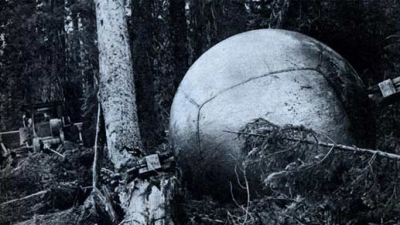

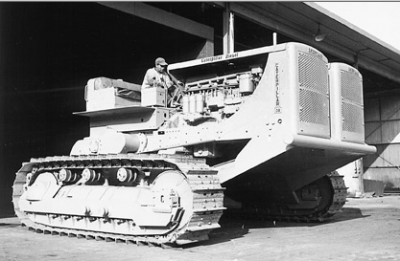
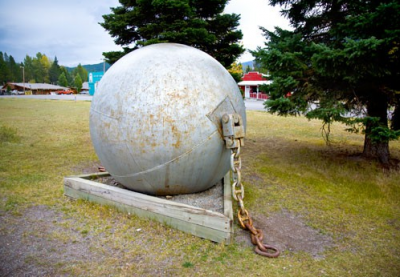







Hey guys…video here. To see the ball and chain in action, start viewing around a minute and 15 seconds.
http://www.veoh.com/watch/v29408183beMJc4Gr
Great find, Two Sprints!